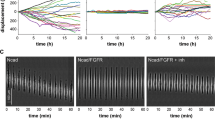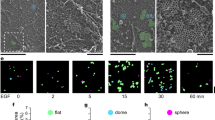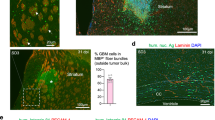Abstract
Loss of expression of neural cell-adhesion molecule (N-CAM) is implicated in the progression of tumour metastasis. Here we show that N-CAM modulates neurite outgrowth and matrix adhesion of β-cells from pancreatic tumours by assembling a fibroblast-growth-factor receptor-4 (FGFR-4) signalling complex, which consists of N-cadherin, FGFR-4, phospholipase Cγ (PLC-γ), the adaptor protein FRS2, pp60c-src, cortactin and growth-associated protein-43 (GAP-43). Dominant-negative FGFR-4, inhibitors of FGFR signalling and anti-β1-integrin antibodies repress matrix adhesion induced by N-CAM. FGF ligands can replace N-CAM in promoting matrix adhesion but not neurite outgrowth. The results indicate that N-CAM stimulates β1-integrin-mediated cell–matrix adhesion by activating FGFR signalling. This is a potential mechanism for preventing the dissemination of metastatic tumour cells.
This is a preview of subscription content, access via your institution
Access options
Subscribe to this journal
Receive 12 print issues and online access
$209.00 per year
only $17.42 per issue
Buy this article
- Purchase on Springer Link
- Instant access to full article PDF
Prices may be subject to local taxes which are calculated during checkout








Similar content being viewed by others
References
Roth, J. et al. Reexpression of poly(sialic acid) units of the neural cell adhesion molecule in Wilms tumour. Proc. Natl Acad. Sci. USA 85, 2999–3003 (1988).
Johnson, J. P. Cell adhesion molecules of the immunoglobulin supergene family and their role in malignant transformation and progression to metastatic disease. Cancer Metastasis Rev. 10, 11–22 (1991).
Moolenaar, C. E. et al. Expression of neural cell adhesion molecule-related sialoglycoprotein in small cell lung cancer and neuroblastoma cell lines H69 and CHP-212. Cancer Res. 50, 1102–1106 (1990).
Kaiser, U., Auerbach, B. & Oldenburg, M. The neural cell adhesion molecule N-CAM in multiple myeloma. Leuk. Lymphoma 20, 389–395 (1996).
Fogar, P. et al. Neural cell adhesion molecule (N-CAM) in gastrointestinal neoplasias. Anticancer Res. 17, 1227–1230 (1997).
Perl, A. K. et al. Reduced expression of neural cell adhesion molecule induces metastatic dissemination of pancreatic β-tumor cells. Nature Med. 5, 286–291 (1999).
Hanahan, D. Heritable formation of pancreatic β-cell tumours in transgenic mice expressing recombinant insulin/simian virus 40 oncogenes. Nature 315, 115–122 (1985).
Perl, A. K., Wilgenbus, P., Dahl, U., Semb, H. & Christofori, G. A causal role for E-cadherin in the transition from adenoma to carcinoma. Nature 392, 190–193 (1998).
Rutishauser, U. Adhesion molecules of the nervous system. Curr. Opin. Neurobiol. 3, 709–715 (1993).
Cunningham, B. A. Cell adhesion molecules as morphoregulators. Curr. Opin. Cell Biol. 7, 628–633 (1995).
Walsh, F. S. & Doherty, P. Neural cell adhesion molecules of the immunoglobulin superfamily: role in axon growth and guidance. Annu. Rev. Cell Dev. Biol. 13, 425–456 (1997).
Crossin, K. L. & Krushel, L. A. Cellular signaling by neural cell adhesion molecules of the immunoglobulin superfamily. Dev. Dyn. 218, 260–279 (2000).
Rutishauser, U. & Landmesser, L. Polysialic acid in the vertebrate nervous system: a promoter of plasticity in cell-cell interactions. Trends Neurosci. 19, 422–427 (1996).
Horstkorte, R., Schachner, M., Magyar, J. P., Vorherr, T. & Schmitz, B. The fourth immunoglobulin-like domain of N-CAM contains a carbohydrate recognition domain for oligomannosidic glycans implicated in association with L1 and neurite outgrowth. J. Cell Biol. 121, 1409–1421 (1993).
Cole, G. J. & Akeson, R. Identification of a heparin binding domain of the neural cell adhesion molecule N-CAM using synthetic peptides. Neuron 2, 1157–1165 (1989).
Probstmeier, R., Kuhn, K. & Schachner, M. Binding properties of the neural cell adhesion molecule to different components of the extracellular matrix. J. Neurochem. 53, 1794–1801 (1989).
Dickson, G. et al. Human muscle neural cell adhesion molecule (N-CAM): identification of a muscle-specific sequence in the extracellular domain. Cell 50, 1119–1130 (1987).
Gower, H. J. et al. Alternative splicing generates a secreted form of N-CAM in muscle and brain. Cell 55, 955–964 (1988).
Langley, O. K., Aletsee-Ufrecht, M. C., Grant, N. J. & Gratzl, M. Expression of the neural cell adhesion molecule N-CAM in endocrine cells. J. Histochem. Cytochem. 37, 781–791 (1989).
Cirulli, V. et al. Expression of neural cell adhesion molecule (N-CAM) in rat islets and its role in islet cell type segregation. J. Cell Sci. 107, 1429–1436 (1994).
Tomasiewicz, H. et al. Genetic deletion of a neural cell adhesion molecule variant (N-CAM-180) produces distinct defects in the central nervous system. Neuron 11, 1163–1174 (1993).
Cremer, H. et al. Inactivation of the N-CAM gene in mice results in size reduction of the olfactory bulb and deficits in spatial learning. Nature 367, 455–459 (1994).
Ono, K., Tomasiewicz, H., Magnuson, T. & Rutishauser, U. N-CAM mutation inhibits tangential neuronal migration and is phenocopied by enzymatic removal of polysialic acid. Neuron 13, 595–609 (1994).
Stork, O. et al. Anxiety and increased 5-HT1A receptor response in N-CAM null mutant mice. J. Neurobiol. 40, 343–355 (1999).
Esni, F. et al. Neural cell adhesion molecule (N-CAM) is required for cell type segregation and normal ultrastructure in pancreatic islets. J. Cell Biol. 144, 325–337 (1999).
Rabinowitz, J. E., Rutishauser, U. & Magnuson, T. Targeted mutation of N-CAM to produce a secreted molecule results in a dominant embryonic lethality. Proc. Natl Acad. Sci. USA 93, 6421–6424 (1996).
Williams, E. J., Furness, J., Walsh, F. S. & Doherty, P. Activation of the FGF receptor underlies neurite outgrowth stimulated by L1, N-CAM, and N-cadherin. Neuron 13, 583–594 (1994).
Doherty, P. & Walsh, F. S. Signal transduction events underlying neurite outgrowth stimulated by cell adhesion molecules. Curr Opin Neurobiol. 4, 49–55 (1994).
Doherty, P. & Walsh, F. S. CAM-FGF receptor interactions: a model for axonal growth. Mol. Cell Neurosci. 8, 99–111 (1996).
Saffell, J. L., Williams, E. J., Mason, I. J., Walsh, F. S. & Doherty, P. Expression of a dominant negative FGF receptor inhibits axonal growth and FGF receptor phosphorylation stimulated by CAMs. Neuron 18, 231–242 (1997).
Hall, H. et al. Inhibition of FGF-stimulated phosphatidylinositol hydrolysis and neurite outgrowth by a cell-membrane permeable phosphopeptide. Curr. Biol. 6, 580–587 (1996).
Corbit, K. C., Foster, D. A. & Rosner, M. R. Protein kinase Cδ mediates neurogenic but not mitogenic activation of mitogen-activated protein kinase in neuronal cells. Mol. Cell Biol. 19, 4209–4218 (1999).
Schmid, R. S. et al. N-CAM stimulates the Ras-MAPK pathway and CREB phosphorylation in neuronal cells. J. Neurobiol. 38, 542–558 (1999).
Kolkova, K., Novitskaya, V., Pedersen, N., Berezin, V. & Bock, E. Neural cell adhesion molecule-stimulated neurite outgrowth depends on activation of protein kinase C and the ras-mitogen-activated protein kinase pathway. J. Neurosci. 20, 2238–2246 (2000).
Beggs, H. E., Baragona, S. C., Hemperly, J. J. & Maness, P. F. N-CAM140 interacts with the focal adhesion kinase p125 (FAK) and the SRC-related tyrosine kinase p59(fyn). J. Biol. Chem. 272, 8310–8319 (1997).
Williams, E. J., Furness, J., Walsh, F. S. & Doherty, P. Characterisation of the second messenger pathway underlying neurite outgrowth stimulated by FGF. Development 120, 1685–1693 (1994).
Ronn, L. C. et al. Identification of a neuritogenic ligand of the neural cell adhesion molecule using a combinatorial library of synthetic peptides. Nature Biotechnol. 17, 1000–1005 (1999).
Meiri, K. F., Saffell, J. L., Walsh, F. S. & Doherty, P. Neurite outgrowth stimulated by neural cell adhesion molecules requires growth-associated protein-43 (GAP-43) function and is associated with GAP-43 phosphorylation in growth cones. J. Neurosci. 18, 10429–10437 (1998).
Varnum-Finney, B. & Reichardt, L. Vinculin-deficient PC12 cell lines extend unstable lamellipodia and filopodia and have a reduced rate of neurite outgrowth. J. Cell Biol. 127, 1071–1084 (1994).
Olson, D. C., Deng, C. & Hanahan, D. Fibroblast growth factor receptor 4, implicated in progression of islet cell carcinogenesis by its expression profile, does not contribute functionally. Cell Growth Differ. 9, 557–564 (1998).
Zhan, X., Plourde, C., Hu, X., Friesel, R. & Maciag, T. Association of fibroblast growth factor receptor-1 with c-Src correlates with association between c-Src and cortactin. J. Biol. Chem. 269, 20221–20224 (1994).
Vainikka, S., Joukov, V., Klint, P. & Alitalo, K. Association of a 85-kDa serine kinase with activated fibroblast growth factor receptor-4. J. Biol. Chem. 271, 1270–1273 (1996).
Moller, C. J. et al. Differential expression of neural cell adhesion molecule and cadherins in pancreatic islets, glucagonomas, and insulinomas. Mol. Endocrinol. 6, 1332–1342 (1992).
Ignelzi, M. A. Jr, Miller, D. R., Soriano, P. & Maness, P. F. Impaired neurite outgrowth of src-minus cerebellar neurons on the cell adhesion molecule L1. Neuron 12, 873–884 (1994).
Beggs, H. E., Soriano, P. & Maness, P. F. N-CAM-dependent neurite outgrowth is inhibited in neurons from Fyn-minus mice. J. Cell Biol. 127, 825–833 (1994).
Kinnunen, T. et al. Cortactin-Src kinase signaling pathway is involved in N-syndecan- dependent neurite outgrowth. J. Biol. Chem. 273, 10702–10708 (1998).
Efrat, S. et al. β-cell lines derived from transgenic mice expressing a hybrid insulin gene-oncogene. Proc. Natl Acad. Sci. USA 85, 9037–9041 (1988).
Matzner, Y., Vlodavsky, I., Michaeli, R. I. & Eldor, A. Selective inhibition of neutrophil activation by the subendothelial extracellular matrix: possible role in protection of the vessel wall during diapedesis. Exp. Cell Res. 189, 233–240 (1990).
Cavallaro, U. et al. FGF-2 stimulates migration of Kaposi's sarcoma-like vascular cells by HGF-dependent relocalization of the urokinase receptor. FASEB J. 12, 1027–1034 (1998).
Acknowledgements
We thank P. Wilgenbus for technical support, K. Paiha and P. Steinlein for confocal microscopy, K. Alitalo, A. Ullrich, H. Semb, A. Vecchi and Yoshimoto Pharmaceuticals for cells and reagents, and E. Wagner, B. Dickson and M. Cotten for critical comments on the manuscript. This work was supported by Boehringer Ingelheim, by the Austrian Industrial Research Promotion Fund, and the Austrian Science Foundation. U.C. is enrolled in the Doctoral Programme in Experimental Pathology of the University of Florence. J.N. was in part supported by a postdoctoral fellowship from the Deutsche Akademische Austauschdienst.
Author information
Authors and Affiliations
Corresponding author
Supplementary information
Download plugins
Figure S1 Cell–cell adhesion is not significantly impaired in N-CAM-deficient tumour β-cells. (PDF 283 kb)
Figure S2 N-CAM-associated tyrosine phophorylation.
Figure S3 Significance of the N-CAM/FGFR-4/N-cadherin signalling complex.
Figure S4 Activation of p42/44 MAPK.
Figure S5 A model of N-CAM-mediated signal transduction in tumour β-cells.
Cell–cell adhesion is not significantly impaired in N-CAM-deficient tumour β-cells.
Figure S2 N-CAM-associated tyrosine phophorylation.
Figure S3 Significance of the N-CAM/FGFR-4/N-cadherin signalling complex.
Figure S4 Activation of p42/44 MAPK.
Figure S5 A model of N-CAM-mediated signal transduction in tumour β-cells.
Rights and permissions
About this article
Cite this article
Cavallaro, U., Niedermeyer, J., Fuxa, M. et al. N-CAM modulates tumour-cell adhesion to matrix by inducing FGF-receptor signalling. Nat Cell Biol 3, 650–657 (2001). https://doi.org/10.1038/35083041
Received:
Revised:
Accepted:
Published:
Issue Date:
DOI: https://doi.org/10.1038/35083041
This article is cited by
-
Targeting APLN/APJ restores blood-testis barrier and improves spermatogenesis in murine and human diabetic models
Nature Communications (2022)
-
NCAM1/FGF module serves as a putative pleuropulmonary blastoma therapeutic target
Oncogenesis (2019)
-
N-cadherin in cancer metastasis, its emerging role in haematological malignancies and potential as a therapeutic target in cancer
BMC Cancer (2018)
-
Biology and evolution of poorly differentiated neuroendocrine tumors
Nature Medicine (2017)
-
Tinospora cordifolia Induces Differentiation and Senescence Pathways in Neuroblastoma Cells
Molecular Neurobiology (2015)



